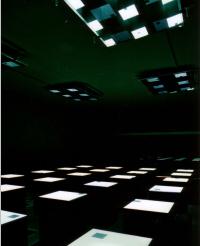
michael aschauer, norbert pfaffenbichler, lotte schreiber



Fundamental Considerations
Binary code is the basis of every digital computer system. Data in and of themselves are neutral; it is only the process of updating them that calls for interpretation by programs-i.e. the stored information must be translated into an event that human beings can perceive. Thus, for example, both optical and acoustic results can be generated from one and the same batch of data. The installation on display here is a systematic and categorical treatment of this phenomenon-that is to say, a simple binary code is translated into spatial, acoustic and optical reference systems. In going about this, we have sought common denominators and dispensed with decorative elements so that the fundamental structure is identical with the final work. The installation presents itself in the form of its own skeleton. Music is by definition the deliberate organization of sound in time (and in space), just as a (motion) picture is the organization of forms on a physical surface (in time) and architecture is the plastic organization of space. A principle that could not conceivably be any simpler is invoked as the basis for a composition and applied in these three disciplines.
The System
This work is based on the bit system, and translates the four possible
states that two bits can represent (00, 01, 10, 11) into the Cartesian
system of coordinates. The result is the definition of four distinct points
whose positions with respect to one another describe the form of a
rectangle (which, in turn, corresponds to the shape of a pixel, the
smallest visual entity of the computer system).
The establishment of six axes of movement lays down a finite number of
possible position changes of the four defining points and thus yields 24
different sequences of movements within the specified geometric system (see
the diagram). Every possible pattern of movement is combined with all
others and played out in all variations with respect to one another, which
yields a finite number of 24! (twenty-four factorial) different
permutations.
Once a bloc of 24 permutations has been played out, the layout of the
pixels is rearranged. Just as in a song's refrain, all visible pixels move
in unison in order to then once again regroup and to begin with the next
set of variations. The animation is played out alternately at six different
speeds corresponding to the number of vectors.
The installation consists of 24 pedestals featuring a rectangular base measuring 50 x 50 x 75 cm, which are set up in a uniform matrix within the exhibition space. The top surface of each of these pedestals displays a single animated pixel that horizontally, vertically and diagonally scans the axes of the pedestal's rectangular upper surface. Visitors to the installation can move about freely among these pedestals.
The audio composition is based on the same system as the animation. Here, 24 loudspeakers playing a finite number of non-repeating combinations are mounted in the 24 pedestals. Serving as acoustic raw material are digitally generated wave forms-sine, sawtooth, noise-and a direct interpretation of the image movements into sound movements on the smallest digital-acoustic entity of a sample value.
It would take approximately 19,674,289,755,600,000 years to play out all possible combinations of this finite spatial/audio/visual composition.
Technical Data
4 PCs - powered by free software (debian/GNU linux, pd, gem)24 loudspeakers JBL Control1, 12 Amps,
3 ADAT D/A RME, 1 RME hdsp9652
4 data beams, 8 mirrors, 1 LCD Monitor,




Credits
24!
Michael Aschauer
Norbert Pfaffenbichler
Lotte Schreiber
production: Rainer Jessl / Norbert Schweizer
programming and audio technics: Michael Aschauer
projection technics: Rainer Jessl
CAD planning hardware and construction: Fred Fürholzer
construction team: Claudia Czimek, Roland Felderer, Mitra Gazvini, Martin Haselsteiner, Dietrich Killer, Franz Obojes, Franz Quirchtmayr, Andreas Steindl, Michael Weingärtner
production office: Karin Pils
director: Martin Sturm
curator: Roland Schöny
4th to 27th of April, 2003
O.K Center for Contemporary Art
Dametzstraße 30, A-4020 Linz
http://www.ok-centrum.at
Contact
mailto:24 [at] ash.to

[ images ]   [ video ]  24.mp4 [mpeg-4; 8,1 MB]
24.mp4 [mpeg-4; 8,1 MB] 24.avi [avi divX; 9 MB]
24.avi [avi divX; 9 MB][ sounds ]  in-the-room_1.mp3
| 4,1 MB in-the-room_1.mp3
| 4,1 MB inside the installation (4:20 min)  just-2-of-24_1.mp3
| 3,0 MB just-2-of-24_1.mp3
| 3,0 MB 2 out of 24 loudspeakers (3:09 min) [ concept ]  2bit_komb_o6.pdf | 1,2 MB 2bit_komb_o6.pdf | 1,2 MBconcept as PDF (german only!) [ contact ] mailto:24 [at] ash.to |